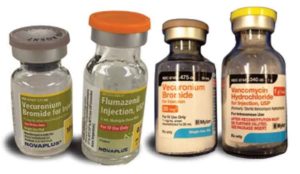Paralyzed by Mistakes: Reassess the Safety of Neuromuscular Blockers in Your Facility
Errors with neuromuscular blockers can be attributed to one or more common causes. The following provides a sampling of the causes of errors with examples.
Look-alike packaging and labeling
An ED nurse administered pancuronium instead of influenza vaccine to several patients. The vials were the same size, and the labels were quite similar. The look-alike vials had been stored next to each other in the refrigerator. The patients experienced dyspnea and respiratory depression but, fortunately, sustained no permanent injuries.
Several practitioners reported concern regarding the similarity of vials of flumazenil 0.5 mg/5 mL and vecuronium 10 mg from NOVAPLUS once the different colored caps have been removed (see Figure 1). Both may be stored in procedural areas, increasing the risk of a mix-up.

Similar colors and label graphics contribute to Mylan’s vecuronium 20 mg and vancomycin 1 g vials looking alike (see Figure 1), especially with the caps removed. Both contain white lyophilized powder that requires reconstitution.
Look-alike drug names
NARCAN (naloxone) and NORCURON (vecuronium) have been confused with written and verbal orders. In one case, a nurse transcribed a verbal order for Narcan correctly, but a pharmacist misread the order and dispensed Norcuron. The nurse thought Norcuron was the generic name for Narcan and administered it. In another case, a physician prescribed Narcan but an ICU nurse did not recognize the drug on the automated dispensing cabinet (ADC) screen because it was listed by its generic name. She intended to ask a coworker for Narcan’s generic name, but she mistakenly asked for the generic name of Norcuron. She then removed vecuronium from the ADC and administered it. The patient arrested, was resuscitated and placed on a ventilator, and later fully recovered.
Unsafe mnemonics
During pharmacy entry of an order for an infusion of cisplatin, the mnemonic computer rule after entering “cis” completed the drug field name with cisatracurium, generating a label for the neuromuscular blocker, which was prepared and dispensed (Santell, 2006).
Drug administration after extubation
A ventilated ICU patient was receiving vecuronium and a potassium chloride infusion. After the patient was extubated, an infusion bag containing vecuronium remained in the room and was mistaken as a potassium chloride infusion. Soon after the medication was started, the patient arrested, requiring intubation and ventilation for six more hours.
Unlabeled and mislabeled syringes
Prefilled syringes of saline flushes were not available in the ED, so nurses prepared a supply each day from multiple-dose vials. Vecuronium had recently been prepared for a trauma patient in the ED, but it was not used. The syringe was not labeled and was inadvertently placed with the saline flush syringes. The syringe containing vecuronium was later used to flush the IV line of a 3-year-old child. The child became flaccid and stopped breathing. She was quickly intubated and ventilated, so permanent harm was averted.
An anesthesiologist was interrupted while preparing syringes of midazolam and rocuronium (Santell, 2006). When he returned, he administered the contents of one syringe to a patient in the holding area, believing it contained midazolam. He was again called away, and when he returned, the patient was unresponsive. The patient was intubated and given a reversal agent, and surgery was postponed. It was later determined that the anesthesiologist had administered the syringe containing rocuronium.
A pharmacy prepared batches of succinylcholine and ePHEDrine in ready-to-use syringes for the labor and delivery unit. The technician prepared both correctly and placed them in a divided bin to be checked. Either the labels were placed in the wrong compartments, or they were placed in the correct compartments but were applied to the wrong syringes. A dose of succinylcholine was administered IV instead of ePHEDrine to treat hypotension. The patient experienced respiratory arrest but was resuscitated successfully.
Unsafe storage
Atracurium was administered instead of hepatitis B vaccine to several infants, who developed respiratory distress. One infant sustained permanent injury and another died. Neuromuscular blockers had never been available as unit stock in the nursery. An anesthesiologist from a nearby OR had placed the atracurium vial in the nursery refrigerator near look-alike vaccine vials. Similar mix-ups with vaccines continue to occur (Roberts, 2014).
In a pediatric ICU, a respiratory therapist obtained what he thought was a sterile water vial to prepare a nebulizer treatment. As he was piercing the stopper, he noticed that he had accidentally grabbed a vial of atracurium that someone had inadvertently returned to a respiratory box in the refrigerator.
